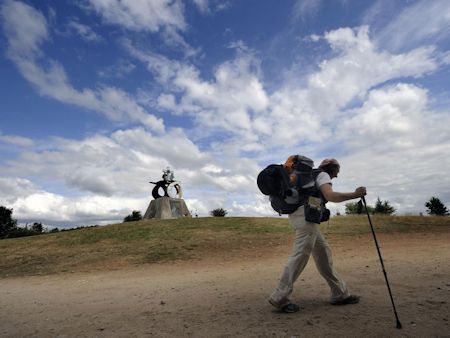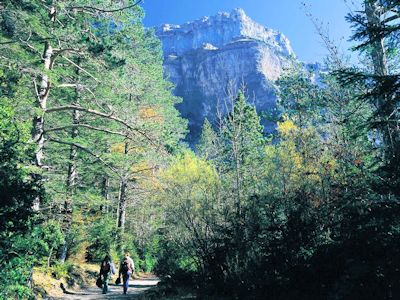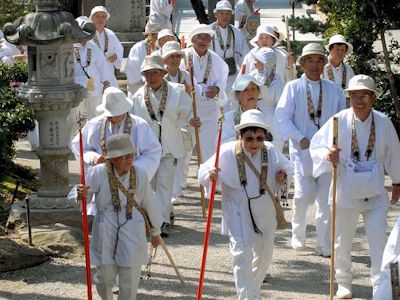|
 |
|
 |
|
Last yearend, a lady, living in Santiago de Compostela, Spain, introduced on the Facebook an interesting article carried on INDEPENDENT, UK, titled "Japan hopes to follow Camino de Santiago's path to marketing success with 750-mile Buddhist pilgrimage".
I have tried to translate it into Japanese for myself and who may be happy
to know it.
There probably are several incorrect translations and non-understandable
sentences in my work. Please forgive me since it is the limit of my ability. |
| - - - - - - - - - - - - - |
| For centuries, religious pilgrims, and latterly thrill-seekers and those wanting to “find themselves”, have undertaken a month-long trek across northern Spain, along the Camino de Santiago.
Few, if any, of the 200,000 or so people who complete the walk each year will realise that it is now being used as a blueprint to market and promote others around the world. The latest is Japan, which is hoping to use the popularity of the Camino to sell its own pilgrimage, the Way of the 88 Temples, a 750-mile path through the island of Shikoku’s Buddhist past.
Both walks have their roots in religious experience. The Camino de Santiago, or Way of St James, actually covers several routes through northern Spain, which eventually lead to the magnificent cathedral at Santiago de Compostela. The cathedral is the supposed resting place of James the Apostle, whose remains were said to have been brought to Spain and interred in a crypt after he was beheaded in Jerusalem in AD44.
|
|
| 過去何世紀にもわたって敬虔な巡礼者たちが、加えて近年はスリルを求めたり自分探しを志す人たちが、スペイン北部のサンチャゴ巡礼路を1ヶ月かけて歩いてきました。
毎年約20万人の巡礼者のうち巡礼を果たし終えるのはほんのわずかの人たちです。その彼らは巡礼を全うして、この路が、世界中のこのような路を企画し宣伝する青写真として使われていることを知るでしょう。最新情報によりますと、日本では四国八十八箇所(四国遍路、四国巡拝とも言う)のお寺を巡る750マイル(1,200キロ)の巡礼路を売り出そうと、このサンチャゴ巡礼路の評判にあやかろうとしています。
両国どちらの巡礼路も宗教心に根ざしています。サンチャゴ巡礼路(セント・ジェームズへの道)は、事実上スペイン北部のいくつかの道を指しています。いずれの道もサンチャゴ・デ・コンポステーラの荘厳な大聖堂を目指しています。
大聖堂は伝道者ジェームズを安置していると言われています。その遺体は、紀元44年にエルサレムで打ち首の刑を受けた後、スペインに移され、この地下聖堂に埋葬されました。
|
|
 |
|
| What will interest the Japanese tourist authorities more than the legend of St James, however, is the success that their counterparts in Spain have had at marketing the Camino. The city of Santiago is taken over by walking shops and souvenir outlets selling T-shirts and furry toys linked to the Camino; the hotels and hostels do a roaring trade.
Back in the 1980s, however, no more than a trickle of people travelled to Spain for the walk. In the Middle Ages, it was a well-travelled route but, over the centuries, the black death, the Protestant reformation, wars in Europe and the Spanish dictatorship, meant that the popularity of the Camino fell in decline.
|
|
しかしながら、セント・ジェームズの伝説よりも日本の観光当局をもっと惹きつけるのは、彼らの同業者がサンチャゴ巡礼路を売り出してきた成功例です。
サンチャゴ市は、巡礼路にあやかったTシャツや毛皮製のおもちゃを売る露店、みやげ物店で賑わっています。ホテルやホステルも活気づいています。
しかし1980年代にさかのぼりますと、当時スペインを歩いて旅する人はほんの少しでした。はるか中世では、この道は旅に適していたのですが、世紀をまたいで、ペスト(black death)、宗教改革、ヨーロッパとスペインの覇権争いといった出来事が巡礼路を衰退させていきました。
|
|
Comparison between
Camino de Santiago and Way of the 88 Temples |
|
|
Camino de Santiago |
Way of the 88 Temples |
| Distance |
478 miles (along the most popular route, the French way) |
750 miles |
| Religious Significance |
a Catholic pilgrimage that ends at the cathedral in Santiago de Compostela, the supposed final resting place of James the Apostle |
a Buddhist tradition. The walk was supposedly completed by the famous Buddhist monk Kukai |
| Number of pilgrims each year |
approximately 200,000 |
about 500,000, mainly Japanese |
| The clothes |
modern hiking gear. Waterproofs are especially important |
white shirts and sedge hats |
| Time needed to complete |
about a month |
about a month |
| Alternative modes of transport |
bikes, and now the Spanish state railway company offers a luxury train journey as an alternative |
Some pilgrims give up on the walking and take a taxi. |
|
|
| サンチャゴ巡礼路と四国八十八箇所巡りの比較 |
|
|
サンチャゴ |
四国八十八箇所 |
| 距離 |
478マイル(765 km)
フランスからの巡礼路と呼ばれる最も人気のある路 |
750マイル(1,200 km) |
| 宗教的重要性 |
サンチャゴ大聖堂が終点のカトリック巡礼路(伝道師ジェームズの安息所) |
仏教
空海(弘法大師)が開いた。 |
| 巡礼者 |
約20万人・年 |
約50万人・年
日本人が大半 |
| 服装 |
ハイキング姿(防水であること) |
白装束、菅笠 |
| 所要日数 |
約1ヶ月 |
約1ヶ月 |
| 徒歩以外の手段 |
バイク |
最近は鉄道による豪華な旅を味わえる。 徒歩をあきらめて、タクシーを利用する人たちもいる。 |
|
|
| Concerned that the walk would be lost for ever, the authorities in Galicia, the north-western Spanish region that is home to Santiago de Compostela, began a campaign to reinvigorate the Camino.
The vast majority of those who complete the Camino these days are foreigners. It was recognised as a “European cultural route” in 1987 and later was named a Unesco world heritage site.
The turnaround has been an obvious success and it is this that the Japanese want to tap in to. Alberto Núñez Feijóo, the head of the Galician government, and his counterpart from Japan’s Kagawa province, an area on Shikoku island, held a meeting in November and agreed to work together to promote the Japanese pilgrimage. Almost half a million Japanese tourists visit Spain each year.
The ultimate goal, according to the Japanese, is to have the Way of the 88 Temples “recognised as a world heritage site, based on learning from the long and abundant experience that the Camino de Santiago possesses”.
|
|
スペインの北西部にあって、サンチャゴ・デ・コンポステーラ市のある県ガリシアの県庁は、このままでは徒歩による巡礼者が無くなってしまうのではないかと心配して、徒歩巡礼を活発化するキャンペーンをはじめました。
最近サンチャゴ巡礼を果たす人たちのほとんどが外国人です。1987年に〝ヨーロッパ文化の道〟と認定され、その後ユネスコの世界遺産になりました。
明らかに方向転換が成功に導いてきたのです。そしてそれが日本人をうならせているのです。
ガリシア県知事のアルベルト・フェイジョー氏と四国の香川県知事が11月に会談し、日本からの巡礼を共同して促進することで合意しました。これによって、毎年日本から約50万人の旅行客を見込めそうです。
こうした日本人たちが抱いている最終目標は、サンチャゴ巡礼路が持つ長い豊富な経験を学び取り、それによって八十八箇所巡拝路が世界遺産に認定されることです。
|
|
 |
|
| It would seem that they are already en route to achieving that goal. The Shikoku trek already has a number its own customs and traditions: many of the walkers wear white clothes, topped off with sedge hats. That said, if the Camino is at least in part a test of human stamina, many of those who complete the Japanese trail today use cars, bikes or even taxis. About half a million pilgrims walk the circular Japanese route each year, but the vast majority are Japanese.
Traditionally, pilgrims complete the walk in a clockwise direction, but it has recently been considered good luck to complete the route the other way round.
”Camino de Santiago's Success"
End
English Reading: 9' 48"
|
|
どうやら日本人は彼らの目標の達成段階にあるようです。
四国巡礼路はすでに独自の慣習・伝統を数多く持ち合わせています。(例えば、多くの巡拝者は白装束に菅笠姿です。)
とはいえ、サンチャゴ巡礼路が、少なくとも幾分は、体力テストの一つの目安であるとすれば、現在四国巡礼を果たしている人たちの多くは、自動車やバイクや、場合によってはタクシーを利用しているということです。
毎年約50万人の巡礼者がこの四国巡礼路を歩いていますが、そのほとんどが日本人です。
伝統的には、巡礼者は時計回りに巡ってきました。しかし最近では、反時計回りも御利益があると思われています。
「サンチャゴ巡礼路の成功例」
おわり
|
|
| 和文朗読: 8分31秒 |
|
| 和文再朗読(2023.09.01 ) 6:15 |
|
| Close 閉じる |
|
|
|